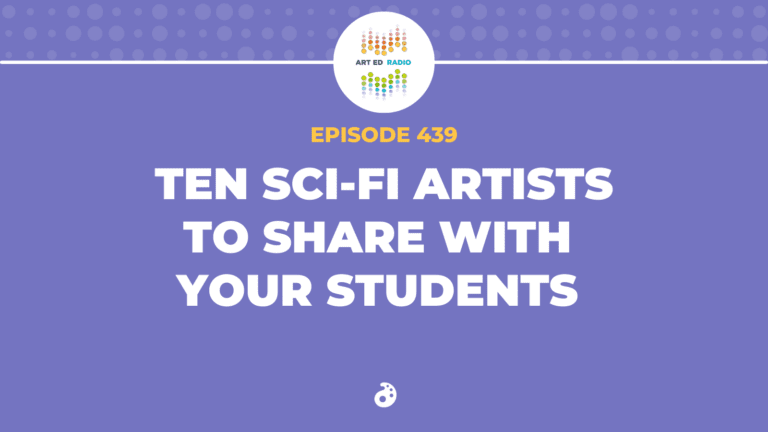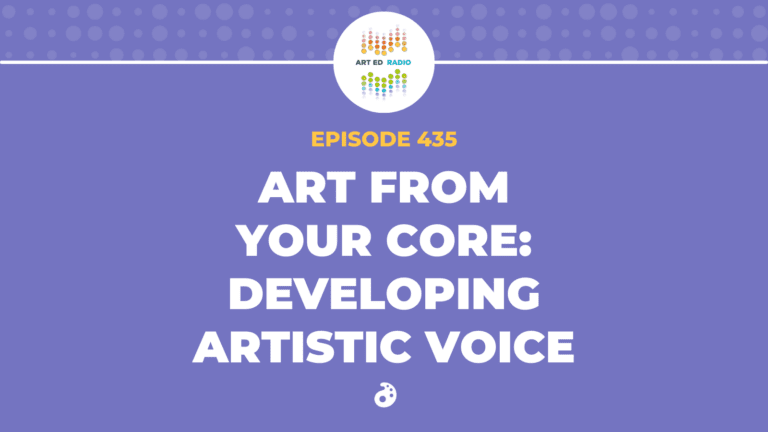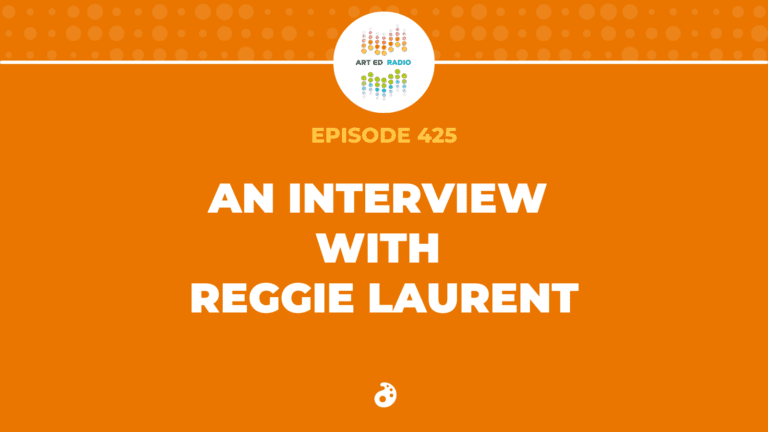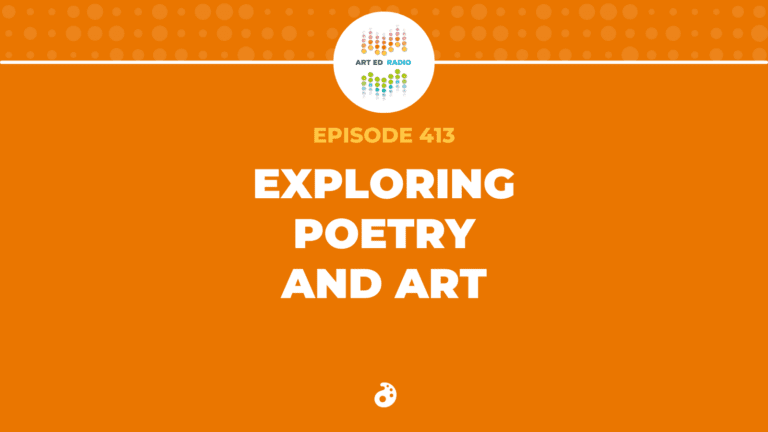Tim is passionate about art history, and making it a vibrant, exciting subject for our students. It’s time to move past those boring slideshows in darkened rooms. So how do we do that? AOE writer Abby Schukei joins Tim as they talk about how to make art history intriguing for your students (6:00), how art history can inspire students’ own work (12:00), and share some of their favorite artists that your students will love (16:30). Full episode transcript below.
Resources and Links:
Abby and Tim talked a lot about the resources they use and the artists they love. Links are below:
- NGA Kids
- Artrageous with Nate
- Yis Goodwin (aka Nosego)
- Jen Stark
- Dan Lam
- James Turrell
- Ai Weiwei
- Ana Mendieta
- 11 Artists Inspired by Science
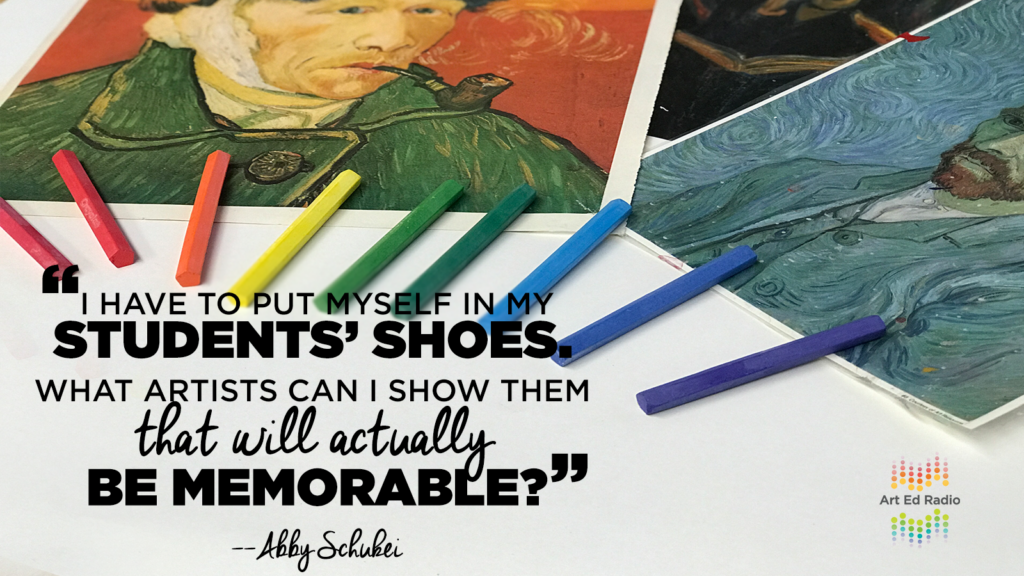
Transcript
Welcome to Art Ed Radio, the podcast for art teachers. This show’s produced by The Art of Education, and I’m your host Tim Bogatz.
Today we are talking art history because it is art history week on The Art of Ed. We’ve got a lot of great things coming including this incredible podcast. Abby Schukei, AOE writer extraordinaire is on today to talk about what art history looks like in her room, the artists she presents to her kids and what she wants her kids to know and learn when they’re talking art history. And if you’re on the AOE site already this week, you probably saw her article on art history Fridays and you have a little bit of insight into what she does with her kids. There are a lot of great ideas there so make sure you check it out if you haven’t seen it yet and we’ll dive in just a little bit here in the interview today.
We also have Wynita’s article coming tomorrow about the Harlem renaissance and the big ideas it can inspire. And finally I have an article coming on Friday about some of my favorite surrealists, the ones your kids really need to know. If all of that’s not enough, I also have a PRO Learning Pack that was released at the beginning of the month about art history strategies for the secondary classroom. There are 17 videos, 13 resources you can download and use immediately. And it’s basically everything I know about teaching art history. Make sure you go check that out at theartofed.com/pro. I know that’s a lot of housekeeping but there are just so many great things going on that I’m really, really excited about. I’m an art history nerd so all of this stuff is really cool and I’m so glad that we can share it all.
I hope that this podcast can be part of that and we’ve got a lot to talk about today with Abby so we’re going to get there in just a second. The main thing we’re going to cover is how we make art history exciting or how we make art history intriguing for our kids because we as art teachers have this mindset of art history being stuffy and boring and irrelevant. It’s that whole memorizing slides in a dark room idea of how we used to do things. I feel like we can really change that mindset with our kids that our learning about art history right now. Hey, we can make it fun. We can make it exciting. We can make it relevant and relatable. Because art history can be hands on as Abby’s going to talk about here in a little bit. Art history can be a vehicle for great storytelling and discussion and higher order thinking. That’s how we should do it.
As you listen to this, I want you to ask yourself, what are you doing with art history? How do you make it fun or relevant or exciting in your classroom? How do you get your kids excited about art history? How does it influence their art making? Abby and I are going to talk about all of these things today and answer all of the questions about what it looks like in each of our classrooms and hopefully you can take some of the ideas we talk about and take them back to your students. Let me bring on Abby now and we will get the interview started.
All right and Abby Schukei is here. Abby, how are you?
Abby: I’m doing good. How are you doing?
Tim: I am doing great and I am excited to talk art history because it is one of my favorite subjects and that’s why I wanted to have you on because I know you have a lot of interest in art history, especially a lot of interest with contemporary artists. Can you talk just a little bit about why art history is just so intriguing to you?
Abby: It actually comes from my early hatred of history. I remember being in, even in high school, world history, American history just that subject alone was boring to me. It seemed so dry. Then when I was able to grasp onto art history a little bit which the first time I ever really remember taking an art history class I was a junior or senior in high school and I found that it actually allowed me to connect and learn about all of that history that I hated. Then I don’t think it was until college, and the intro to art history classes, your art history one, art history two classes that every one of us had to take probably some time in our art schooling was just a little, was too broad a little bit for me. There’s just way too much there.
It wasn’t until I took an American art history class that I was like, holy smokes, this is awesome. It was one of the things that I remember the most is talking about Alexander Gardner and taking photos of the Civil War, something I wasn’t really interested in before that. It really allowed me to tap into those things that are actually important and what I needed to know about but it allowed me to become interested in them a little bit more.
Tim: That’s really cool. My wife is going to be upset that you don’t like history class ’cause she teaches history. But I will agree with you because those survey courses, art history 101 and 102, those are boring. But, if you can get into those specialized classes, for me it was one of those so specific, it was modern art from 1960 to 1980 and when you can just dive into really specific courses, that’s where a lot of that love comes from. When you can really study something in depth and it’s really interesting. I want to go back to something you said about making those connections and helping kids learn about the bigger picture. We talk about how it’s, art history, is so intriguing for us but how do we make those connections and how do we make it intriguing for the kids in our classes?
Abby: Sometimes you have to put your personal preferences aside. Sometimes my influences obviously come into my room with my students but I have to put myself in their shoes as far as, what am I going to do? Or, what artists am I going to show them that are going to be memorable to them? Is it going to make them excited? My students aren’t simply just going to learn from, learn everything about art history and one artist but if I’m able to show them a artist that really connect to them and they can actually can relate to, it’s going to make the experience much more worthwhile for them.
Tim: I think so. You’ve really hit the nail on the head when you said you need to make it relevant for our kids. For both of us, that’s why we bring a lot of contemporary artists into our classroom and Melissa Purtee has written about that extensively too. Where kids can relate to that and that’s what’s going to make it really intriguing for them. I want to dive into what art history looks like in your classroom. If I can ask, do you have outside resources that you use? Are you working with museums? Do you have websites? Do you have videos or anything else along those lines? Can you share with people, talk a little bit about what art history does look like when you’re teaching it and how you do it in your classroom?
Abby: Yeah, definitely. There’s a lot of great resources out there, museum based, as far as NGA Kids from the National Gallery of Art is really great. Artrageous with Nate is a YouTube channel but it’s pretty awesome too, which I’ll incorporate a little bit. I find a lot of those kind of resources are challenging for me to use because more of them are focused on the old masters and not necessarily the contemporary things. I actually use Instagram like crazy. Some of the artists that I really know I’ve discovered through Instagram and I’m like, oh my gosh, these people have a mass following on here. Then I’m learn about them that way. I go into this down the tunnel of Instagram artists and I’m like, oh my gosh, there’s this whole world out here.
Part of the reason that I’ve done that is because coming in the middle school setting, I get students coming, they come in from elementary school and literally when I say the word artist it’s like they’re conditioned to scream Vincent van Gogh and Leonardo da Vinci. And I’m like, well that’s great that you know that but there’s this whole other world out there. I want to expose them, once again, to those artists that they’re going to connect to.
I actually got this idea from you, I know it totally looked different in your classroom but when you always used to write about it, incorporate your art history Fridays, I took my own little spin on that where on each Friday we talk about a new artist and sometimes activities will carry over from Friday to Friday but what I do for those is we keep it a short hands on activity. I don’t talk about the artist for more than 10 minutes, I would say five to seven minutes, I key in on the really important things that students are going to remember and then it allows us to use a specific process or technique that’s directly based on that artist. Then you can see over time, it’ll trickle into student’s artwork a little bit just because they were able to learn about a new artist and they were able to take a break from their every day classwork that we’ve been doing each day during the week.
Tim: That’s really cool. I’m actually conflicted right now ’cause I want to talk about myself as always but what you just said has a great segue into my next question. I am going to talk a little bit about my art history Fridays and what I did ’cause we can chat about that real quick so people who aren’t familiar can know and then we can chat about the art making side of things. Basically you can tell me if I’m right here, but it seems like you took my ideas and made it way more fun. You think that’s correct?
Abby: Yeah. I know that you did a lot of cool writing and stuff, but man, our middle schoolers just have to make. But I totally stole it from you.
Tim: Just so people know, my art history Fridays were again, like you talked about, just a quick little presentation about the artist, their best work and I always tried to find people who had really good stories or really engaging artworks that we could talk about. That was always fun. You try and make it a little bit entertaining. And then we would write, we would take notes, we would discuss, we would have kids make sketches, ask questions and just try and incorporate a lot of those higher order thinking skills. It’s just depends on your classroom. I’m teaching a lot of high school advanced courses and kids are already interested in what’s going on so we can dive in a little deeper. But for middle school or maybe for elementary school, don’t you think it works better to get more of those hands on ideas going?
Abby: Absolutely and because they’re able to do those hands on things, that’s what makes it memorable and that’s what actually lets them remember the artist even the next year and going on there ’cause they were able to have that experience.
Tim: Yeah, that’s a very worthwhile goal too. Any time you can get that to stick then it definitely works well. Let’s talk a little bit more about the art making side of things though and maybe how what we’re teaching art history can transfer to what kids are creating. Can you talk specifically about how you see art history inspiring kids? Or how you see it affecting their art making or their day to day outside of the specific projects that you do?
Abby: Sure. One of the things that art history does is it just exposes them to new ideas. Those might be conceptual or it’s a new technique or a new process. Like I said before, after a while you can see some of those ideas show up in their own artwork with a twist. It’s cool to see that because you can see the inspiration at work or you can tell that a student has are taken interest in that particular artist and they’ve made a connection in that way. Isn’t art history really about learning what others have done and why it’s important to our past and why it should be relevant now in our present? By teaching it and by exploring those different things, we’re showing our students that.
Tim: That’s right on. That’s really, really well said. If I can just follow up on that. You talked about what kids get when they’re learning art history. Those new ideas, new concepts and techniques, new processes, are those your goals when you’re presenting art history? Is that what you want them to think about? Or do you have bigger ideas in mind on top of those?
Abby: That’s certainly part of it but I also think one of the coolest things that comes about is if you think about the occupation of an artist, that’s something that’s been around since the beginning of time. You can’t necessarily say that about a basketball player. I don’t know what year basketball got invented but think about cave paintings and all of where art history spans back to, it shows your students that art really is a really important part of our culture. It’s our world, everywhere. Especially not only is it important to your students but can also work as an advocacy tool in showing that no matter what, artists are going to be part of our past, they’re going to be part of our present and our future. And in a day and age where, in especially a school setting the arts are constantly on the chopping block in some regard, that’s a really important thing to instill within our students so that they know why it’s important.
Tim: I completely agree. Your history idea there gave me a little reminder of something I always tell my kids just to show that importance where we can talk about throughout history, we’ve had entire cultures that do not speak. We’ve had entire cultures that don’t have a written language. They have cultures that have never done math. But nowhere in the history of the world has there ever been a culture that does not have art. Every culture has created and there have been artists everywhere throughout the world, throughout time. That’s a really, really important point that you make there and that’s something that we need to get passed onto our kids as well.
But, it’s just about time for us to go. I want to give our listeners a good art history takeaway. If they’re looking for somebody that can show the importance of art or somebody that can really get kids excited about art, who would be three of your favorite artists that you love to show kids and that your kids love to see?
Abby: Mine are all going to be contemporary artists. My first one is Yis Goodwin, he actually goes by Nosego. He’s based out of, first off students are like, “What do mean his name is Nosego?” That’s going to get them excited right there. He’s based out of Philadelphia and his work is crazy dynamic and vibrant and he pulls a surreal twist on it and kids are fascinated by it. They’re often large scale and he’ll work on huge murals and sometimes when we’re talking about artists, I’ll actually go to their Instagram page and project it up there. ‘Cause I’m like, why do I need to make a PowerPoint slide of this when I can just go here. We’ll go in and watch the stories and stuff. And the kids are like, “This is so awesome.” They’re able to relate and go into that. He’s a really good one. Look up Nosego if you don’t know him.
The other one, and you already know that she’s one of my favorites is Jen Stark. There’s just something about her colors and it’s so versatile as far as the abstract design and I’m really big into digital art making. It’s cool to be able to combine both drawing and painting techniques as well as exploring animation a little bit and kids really relate to her. Radical colors and the sculptures that she does too. She’s always a really fun one to get kids excited to.
Then my last one, this one I’ve actually just recently discovered within the last month or so and I am so excited to actually do an art history Friday activity on this. Her name Dan Lamb and she is an artist from the Philippines and she creates these awesome polyurethane blob drips. They’re these big sculptures that hang off surfaces. They’re gross looking and have spikes but they’re so colorful I just got to figure out what I’m going to do with them in my classroom as far as in art history goes. I know that my students are definitely going to love her and some of the awesome stuff that she does.
Tim: Yeah, she sounds fascinating. I need to check her out. If you can stick around for one more minute I’m going to tell you my three.
First up is James Turrell. He is fantastic. He does these lightroom installations which totally mess with all of your sensory perceptions and they are spectacular. He was actually in my 11 Artists Inspired by Science article that came out a little bit ago. As was Jen Stark, by the way. James Turrell also hollowed out a volcano. 40 years he bought a volcano in Arizona, which is pretty spectacular and he’s been working on hollowing it out and creating these rooms that deal with light and optics and perception and it’s absolutely fascinating and my kids are always fascinated by it.
Second, is Ai Weiwei. Spectacular Chinese artist that everybody needs to look up if you’re not familiar with him already. He is so good and has so many great ideas that lead to some awesome discussions in your class.
Finally, third one is Anna Mendieta who is one of my favorite artists of all time. Creates these spectacular ephemeral sculptures and she’s got a super tragic but fascinating backstory with her husband who was a sculptor, Carl Andre and a lot of drama and possible murder and just crazy backstory that you also need to look up and present to your kids.
All three of them are super fascinating and super intriguing to kids. I’ll let you comment on this one quick thing before you go. It’s different for every teacher where if you look at the artists that I love it’s very much about storytelling and having a fascinating way to start discussions with your kids and your favorite artists are people who are really striking visually, bright colors and really lend themselves to a good art making project with your kids. Do you think it’s up to each teacher to find the artists that both fascinate them and will fascinate their kids?
Abby Schukei: Definitely ’cause we’re going to share things with our students that we’re passionate about. I’m looking for artists that I know my students are going to like but I’m also going to feel comfortable talking about them because I genuinely probably hold an interest in them as well.
Tim: Yeah, absolutely. If you’re passionate about something then you’re able to pass that along to your kids as well. That’s awesome and that is a great place for us to leave it. Abby, thank you very much. It’s been fun talking to you.
Abby: Yes, thanks for having me on.
Tim: We will go ahead and end it quickly here because like I said earlier, I’m a huge fan of all things art history and I can end up talking about it for way too long. I want you to think about how you can take one or two of those ideas that we talked about and take them back to your classroom and think about you can improve how you do art history. If you have other ideas on how to do it well or you have cool things that you do with art history in your room, I would love to hear about them. If you want to share that with me, just shoot me an email at radioguys@thearted.com and we can chat. Like I said, I love to talk shop about all of this stuff.
I will also put a list of links on the podcast page for you on the Art of Ed with the resources that Abby mentioned, the articles, the artists we talked about. Everything will be there so make sure you check that out. Thanks again to Abby for joining me tonight, it was a really fun conversation. I would love to have her back her back on again soon but for now I hope you enjoyed this conversation as much as I did and I hope it’s given you a few new ideas on how you can and should be looking at art history in your own classroom.
Art Ed Radio is produced by the Art of Education with audio engineering from Michael Crocker. Make sure you check out the Art of Ed website this week for everything art history related including my article on Friday. And please send me an email if you want to talk about teaching art history, again, radioguys@theartofed.com. Thank you as always for listening and we will see you next week.
Magazine articles and podcasts are opinions of professional education contributors and do not necessarily represent the position of the Art of Education University (AOEU) or its academic offerings. Contributors use terms in the way they are most often talked about in the scope of their educational experiences.
